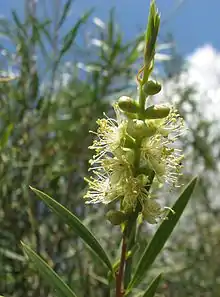Melaleuca faucicola
Melaleuca faucicola commonly known as desert bottlebrush, is a plant in the myrtle family, Myrtaceae and is endemic to the Northern Territory in Australia. (Some Australian state herbaria continue to use the name Callistemon pauciflorus.)[2] It is a shrub or small tree growing only in protected gorges in the ranges of Central Australia such as the Petermann Ranges and has red, cream or white spikes of flowers.
| Desert bottlebrush | |
|---|---|
 | |
| M. faucicola in Geelong Botanic Gardens, Victoria, Australia | |
| Scientific classification | |
| Kingdom: | Plantae |
| Clade: | Tracheophytes |
| Clade: | Angiosperms |
| Clade: | Eudicots |
| Clade: | Rosids |
| Order: | Myrtales |
| Family: | Myrtaceae |
| Genus: | Melaleuca |
| Species: | M. faucicola |
| Binomial name | |
| Melaleuca faucicola | |
| Synonyms[1] | |
|
Callistemon pauciflorus R.D.Spencer & Lumley | |
Description
Melaleuca faucicola is a shrub growing to 1.515 m (5 ft) tall with hard, fissured bark. Its leaves are arranged alternately and are 25–89 mm (1–4 in) long, 3.5–16 mm (0.1–0.6 in) wide, flat, linear to lance-shaped, with a mid-vein, 16 to 20 lateral veins and distinct oil glands.[1]
The flowers red, pink, cream or white. They are arranged in spikes on the ends of branches that continue to grow after flowering and also on the sides of the branches. The spikes are up to 27 mm (1 in) in diameter with 7 to 17 individual flowers. The petals are 2.5–4.4 mm (0.1–0.2 in) long and fall off as the flower ages. There are 52 to 71 stamens in each flower, some of which are joined in bundles. Flowering occurs at unpredictable times throughout the year and is followed by fruit that are woody capsules, 2.8–4.5 mm (0.1–0.2 in) long.[1]
Taxonomy and naming
Melaleuca faucicola was named in 2006 by Lyndley Craven in Novon.[3][4] It had previously been known as Callistemon pauciflorus since Roger David Spencer and Peter F. Lumley first formally described it in 1986 in Muelleria from a specimen collected from the "Serpentine Gorge in the Heavitree Range".[5] The specific epithet (faucicola) is from the Latin faux meaning “throat”, hence "gorge", and -cola meaning "dweller in", referring to the habitat of this species, being in gorge country.[1]
Callistemon pauciflorus is regarded as a synonym of Melaleuca faucicola by the Royal Botanic Gardens, Kew.[6]
Distribution and habitat
This melaleuca occurs in the Central Ranges, MacDonnell Ranges and Petermann Ranges in the Northern Territory,[7] where it grows near waterholes in protected sandstone gorges.[1]
Conservation status
Melaleuca faucicola is classified as "near threatened" in terms of the Northern Territory Parks and Wildlife Conservation Act.[8]
References
- Brophy, Joseph J.; Craven, Lyndley A.; Doran, John C. (2013). Melaleucas : their botany, essential oils and uses. Canberra: Australian Centre for International Agricultural Research. p. 162. ISBN 9781922137517.
- Udovicic, Frank; Spencer, Roger (2012). "New combinations in Callistemon (Myrtaceae)" (PDF). Muelleria. 30 (1): 23–25. Retrieved 11 June 2015.
- "Melaleuca faucicola". APNI. Retrieved 12 June 2015.
- Craven, Lyn A. (2006). "New Combinations in Melaleuca for Australian Species of Callistemon (Myrtaceae)". Novon. 16 (4): 471. doi:10.3417/1055-3177(2006)16[468:NCIMFA]2.0.CO;2. Retrieved 11 June 2015.
- "Callistemon pauciflorus". APNI. Retrieved 12 June 2015.
- "Callistemon pauciflorus". World Checklist of Selected Plant Families (WCSP). Royal Botanic Gardens, Kew.
- "Petermann Ranges and surrounds" (PDF). Northern Territory Government Department of Natural Resources, Environment, the Arts and Sport. Retrieved 25 January 2018.
- "Melaleuca faucicola". Northern Territory Flora Online. Retrieved 3 May 2016.